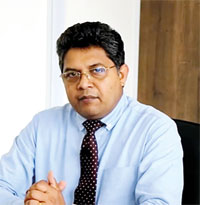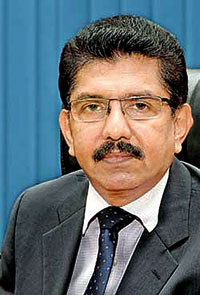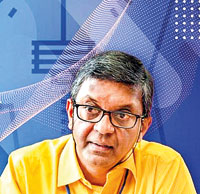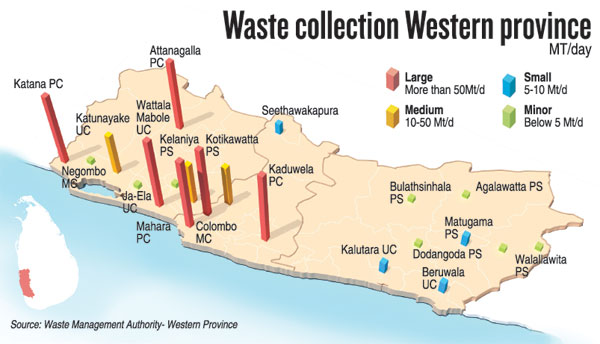News
Western Province sitting atop a mounting disaster
View(s):21 active garbage dumps pose health hazards to people
Pix and text by Rekha Tharangani Fonseka
Not even the Meethotamulla garbage disaster of 2017 has taught a lesson: Scattered all over the Western Province are 21 active garbage dumps in close proximity to human settlements–and people are suffering.
Residents of Muthurajawela and Karadiyana told the Sunday Times that visitors to their homes don’t even want to drink a sip of water from them. They lamented that clean air was only a dream. The environment was even more oppressive during rains.
“And we are endlessly bothered by flies and mosquitoes,” said one. “Even if we tell our plight to the authorities, there is no solution so far. Even a small child isn’t lucky enough to have a breath of fresh air.”

The dump at Karadiyana
“Ministers make promises during elections, making us believe they will even run away with the garbage dump and make it disappear,” said another.
Data from the Western Province Waste Management Authority (WPWMA) identify the dumps as: Ovitiya Watta, Thimbiriyagaha Fort, Ambalanmulla, Pilapitiya paddy fields, Dambu Watta, Sudu Wella, Muthurajawala, Kerawalapitiya, Marina Garden, Manel Gamuwa, Kotikawatta, Seethawaka, Karadiyana, Bulathsinhala, Pohorawatta, Nagoda, Dodangoda, Agalawatta, Vathu Rajapura, Matugama, Walauwatte and Palindanuwara. One of these is inactive.
The dumps are in 49 local government areas. And out of the 8,800 metric tons of garbage generated in the country each day, 58 percent is from within the Western Province–which accounts for just 5.7 percent of Sri Lanka’s total land area–with its higher population density (Colombo has nearly 3.5mn people).

Nalin Mannapperuma
These mountains of waste are damaging both the environment and groundwater sources. “Bacteria activated in organic waste produce methane gas of which the impact on global warming is 30 times more than that of carbon dioxide,” said Professor Ajith de Alwis of the Moratuwa University’s Department of Chemical Process Engineering. “The damage caused to groundwater sewage, clinical waste, batteries and drugs is also enormous.”
Is it only Colombo area garbage that is heaped up in the Western province? How did these dumps build up despite environmental protection measures? What steps have been taken to eradicate this menace?

Anil Jasinghe
“A few officials cannot manage this waste,” maintained Nalin Mannapperuma, WPWMA Director. “It’s just hilarious if people expect a beautiful country like Singapore or Japan while disposing of garbage irregularly around the country. In the Western Province, about 3,500 metric tons of garbage is generated per day, of which 19,000 metric tons can be recycled. The remaining 49 percent is burnt and 15 percent is composted.” But there is still a large quantity left.
“I believe that the existence of several commercial cities in the Western Provinces is the reason for the increase in garbage heaps,” he continued. “People from different parts come to these cities for various needs, making daily consumption quite high. Therefore, waste generation increases. To solve this, we have a 20-year plan which has been implemented in collaboration with JICA (Japan International Cooperating Agency).”

Ajith de Alwis
Through this, programmes for final disposal, waste segregation, turning waste into a resource, reuse and cutting waste generation have been carried out. But the public is responsible for implementing at least three of these components.
For instance, a good way to cut waste is to feed leftovers to animals–but this is not being done, Mr Manapperuma said. A national policy on waste management was only passed in October 2019, two years after the Meethotamulla disaster, he pointed out.
“It is the Environment Ministry’s duty to implement waste management policies,” said Anil Jasinghe, the Secretary. “But taking legal action against miscreants is entrusted with the Central Environment Authority (CEA). Land use is assigned to the Ministry of Local Government and the Ministry of Urban Development and Housing. As you can see, powers are scattered.”
Guidelines have been issued to local councils and local authorities can file lawsuits against illegal dumping. But this alone won’t solve the problem. Many types of plastic were banned from March 31, 2021. It was hoped consumption could be brought to a minimum level.
There have been amendments to the Western Provincial Waste Management Charter of 2007 pertaining to issues such as on-site fines and service charges to be paid by the polluter. There are laws on mixing waste, dumping waste everywhere, burning waste and causing a nuisance to the community. Littering is a punishable offence entailing fines of between Rs 5,000 and 50,000 or imprisonment of three months to one year.
“Many environmental problems can be reduced if the law is implemented properly,” Dr Jasinghe insisted. “Is the law against environmental vandals being enforced?”
Urban waste management is the subject of local government bodies and should be managed according to their respective powers, said Hemantha Jayasinghe, CEA Director-General.
The CEA doesn’t directly intervene in management of municipal solid wastes. It only provides advice and technology. It does make a direct contribution towards reducing pollution caused by industries through environmental protection licences and 44,551 such permits have been granted up to August 31, 2022.
“We have enacted laws under this procedure so that harmful wastes released from industries cannot go to landfills,” Mr Jayasinghe said. “We can enforce the law if the industry that has obtained the licence violates rules and regulations. But it is the responsibility of local authorities to prevent the creation of mountains of garbage.” 
“So far, 21 small and medium compost yards and 49 recycling centres have been established in the Western Province,” said Urban Development Minister Prasanna Ranatunga, when asked what steps were taken to stem the creation of garbage dumps during his tenure as the region’s Chief Minister. “But out of the 3,400 metric tons of garbage collected daily in the Western Province, only 306 metric tons are composted.”
Accordingly, 33 metric tons of compost is produced daily. “Everything else is piled up as garbage dumps,” he said. “To remove these mountains of garbage, a sanitary landfill has been constructed in Aruwakkalu enabling the disposal of 1,200 metric tons of garbage daily.”
At present, he claimed, construction of the Kelaniya waste loading point and Aruwakkalu unloading point is nearly done. Garbage will be taken to Aruwakkalu by train. The wagons, containers and engines are also ready. All residual waste within the Western Province will be collected for transport by train to Aruwakkalu. The WPWMA has also built several compost yards and is running operations.
The Minister, too, said legal authority over municipal solid waste lies with local government bodies. Through the national policy on waste management, the Environment Ministry has integrated all stakeholders and provided them with guidelines and guidance.
“I believe that if proper coordination is established between these institutions in future, a new programme related to garbage can be successfully implemented,” he said. “As the Minister of Urban Development and Housing, I hope to implement a vigorous plan together with all parties in respect of waste management activities within my subject area.”

The best way to say that you found the home of your dreams is by finding it on Hitad.lk. We have listings for apartments for sale or rent in Sri Lanka, no matter what locale you're looking for! Whether you live in Colombo, Galle, Kandy, Matara, Jaffna and more - we've got them all!

